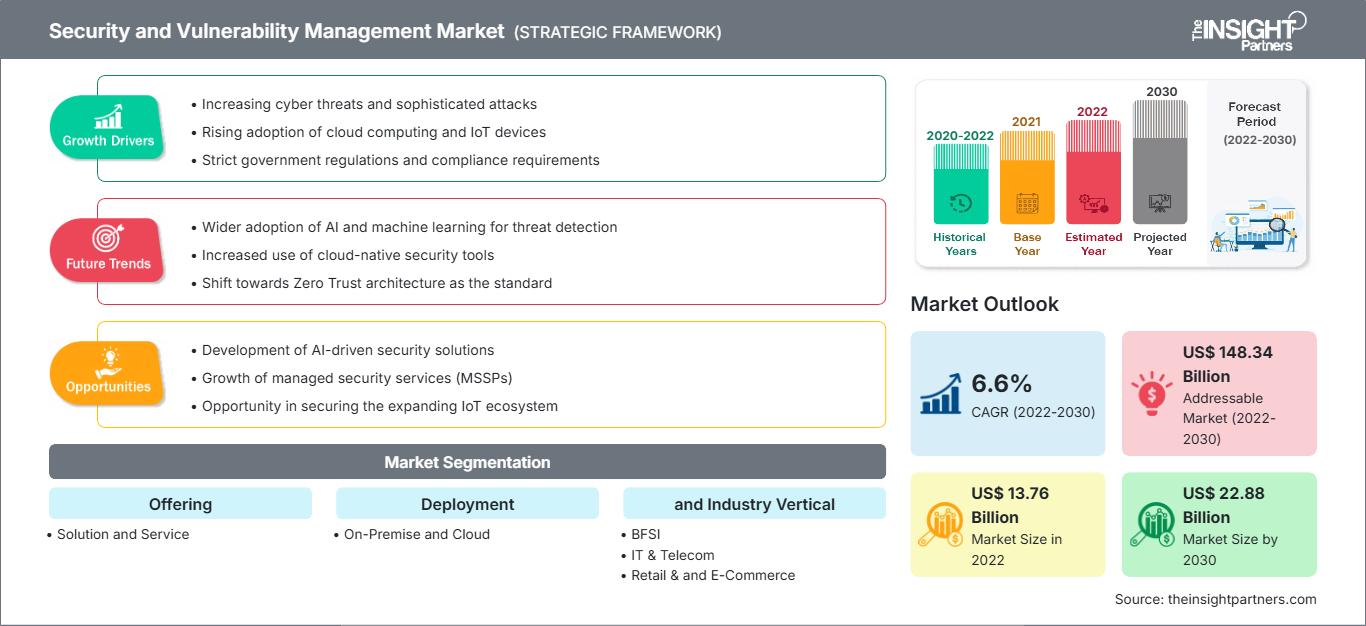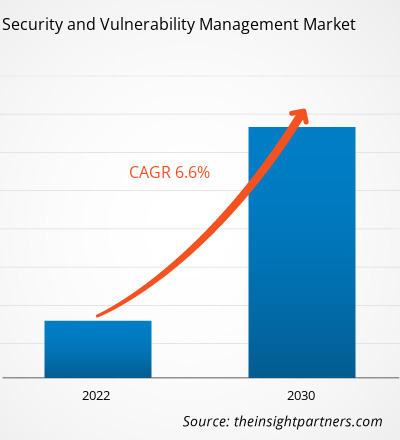[Informe de investigación] Se proyecta que el tamaño del mercado de gestión de seguridad y vulnerabilidad crecerá de US$ 13,76 mil millones en 2022 a US$ 22,88 mil millones en 2030; se estima que el mercado registrará una CAGR de 6,6% de 2022 a 2030.
Perspectiva del analista:
El informe incluye perspectivas de crecimiento debido a las tendencias actuales del mercado de gestión de seguridad y vulnerabilidades y su impacto previsible durante el período de pronóstico. El creciente número de ciberataques y filtraciones de datos a nivel mundial se encuentra entre los factores que impulsan el mercado. Se espera que el aumento de las inversiones en soluciones basadas en IA y la expansión de los sectores de seguros, salud y finanzas impulsen aún más el mercado durante el período de pronóstico. Las estrictas regulaciones gubernamentales relacionadas con la ciberseguridad y la confidencialidad de los datos también benefician al mercado. Además, es probable que la integración de tecnologías modernas como la IA, el aprendizaje automático, las herramientas de análisis de datos y el almacenamiento en la nube genere oportunidades de crecimiento para el mercado de gestión de seguridad y vulnerabilidades en los próximos años.
Descripción general del mercado:
La seguridad es el activo más valioso de una organización y requiere la contribución tanto de tecnología como de capacitación. Las vulnerabilidades se deben a fallos en los sistemas, que podrían dar lugar al acceso no autorizado a información privada. La gestión de la seguridad y las vulnerabilidades consiste en identificar, clasificar, mitigar y corregir vulnerabilidades en el hardware o software de red. Los equipos de seguridad utilizan datos cruciales obtenidos mediante la evaluación de vulnerabilidades para corregirlas en sus redes, facilitando así la evaluación de riesgos y la mitigación de amenazas. Es probable que el aumento de los ciberdelitos y la creciente inversión en procesos de ciberseguridad impulsen el crecimiento del mercado de la seguridad y la gestión de vulnerabilidades en el futuro próximo.
Personalice este informe según sus necesidades
Obtendrá personalización en cualquier informe, sin cargo, incluidas partes de este informe o análisis a nivel de país, paquete de datos de Excel, así como también grandes ofertas y descuentos para empresas emergentes y universidades.
Mercado de gestión de seguridad y vulnerabilidades: perspectivas estratégicas

-
Obtenga las principales tendencias clave del mercado de este informe.Esta muestra GRATUITA incluirá análisis de datos, desde tendencias del mercado hasta estimaciones y pronósticos.
Impulsor del mercado de gestión de seguridad y vulnerabilidades:
El creciente número de ciberataques y filtraciones de datos impulsa el mercado de la seguridad y la gestión de vulnerabilidades.
Según un informe de la AAG publicado en febrero de 2024, el 43 % de las empresas del Reino Unido se enfrentaron a ciberataques en 2022, lo que representa un aumento de aproximadamente el 32 % con respecto a 2020. Esto impulsa la demanda de soluciones y servicios de seguridad y gestión de vulnerabilidades entre los consumidores para proteger datos sensibles y sistemas críticos contra ciberataques. Además, estas soluciones también se utilizan para identificar y abordar vulnerabilidades que ayudan a los usuarios a mitigar los riesgos relacionados con las brechas de seguridad y a proteger datos y sistemas sensibles.
Segmentación y alcance del informe:
El análisis del mercado de gestión de seguridad y vulnerabilidades se realizó considerando los siguientes segmentos: oferta, implementación e industria. Según la oferta, el mercado se segmenta en soluciones y servicios. En términos de implementación, el mercado de gestión de seguridad y vulnerabilidades se clasifica en local y en la nube. Por industria, el mercado se divide en BFSI, TI y telecomunicaciones, comercio minorista y electrónico, salud, gobierno y servicios públicos, entre otros. Por región, el mercado se segmenta en América del Norte, Europa, Asia Pacífico (APAC), Oriente Medio y África (MEA) y América del Sur (SAM).
Análisis segmentario:
Según la industria, el mercado de gestión de seguridad y vulnerabilidades se segmenta en BFSI, TI y telecomunicaciones, comercio minorista y electrónico, atención médica, gobierno y servicios públicos, entre otros. Se prevé que el segmento BFSI ocupe una cuota de mercado significativa en gestión de seguridad y vulnerabilidades durante el período de pronóstico. El crecimiento proyectado de este segmento se atribuye a la creciente digitalización y al creciente número de ciberataques en el sector BFSI, junto con su intenso impacto en las economías nacionales. Según datos del Equipo de Respuesta a Emergencias Informáticas (CERT-In), el sector financiero en India enfrentó más de 1,3 millones de ciberataques entre enero y octubre de 2023, con un promedio de 4400 ataques por día. La ciberseguridad es cada vez más crucial para las instituciones financieras debido a la creciente digitalización en el sector financiero, lo que facilita la expansión del mercado de gestión de seguridad y vulnerabilidades. La digitalización facilita que los ciberatacantes ataquen sitios web y sistemas de transacciones.
Análisis regional:
El alcance geográfico del informe de mercado de gestión de seguridad y vulnerabilidades abarca Norteamérica, Europa, Asia Pacífico, Oriente Medio y África, y Sudamérica y Centroamérica. En términos de ingresos, Norteamérica tuvo la mayor cuota de mercado en gestión de seguridad y vulnerabilidades en 2022. El crecimiento de las inversiones en tecnología de IA, la creciente concienciación sobre las ciberamenazas, las importantes inversiones en ciberseguridad y las estrictas normas y regulaciones del sector financiero impulsan el mercado en esta región. La región está muy centrada en la adopción de soluciones de seguridad integrales para proteger los datos de las ciberamenazas. En octubre de 2023, el Comité de Asuntos Exteriores de la Cámara de Representantes y el Comité de Seguridad Nacional y Asuntos Gubernamentales del Senado sufrieron un ciberataque de hackers vietnamitas que intentaban instalar software espía en los teléfonos de periodistas. Estos ciberataques han impulsado la demanda de soluciones de gestión de vulnerabilidades entre los consumidores para proteger sus datos confidenciales. La gestión de vulnerabilidades permite a los usuarios fortalecer sus sistemas, proteger sus datos y cumplir con los estándares de seguridad.
Análisis de los jugadores clave:
Microsoft Corp; International Business Machines Corp;, Hewlett Packard Enterprise Development LP; Qualys Inc; Tenable Holdings Inc; Rapid7; CrowdStrike Holdings Inc; Fortra, LLC; Skybox Security, Inc; y Cisco Systems Inc se encuentran entre las empresas clave perfiladas en el informe de mercado de gestión de seguridad y vulnerabilidad.
Perspectivas regionales del mercado de gestión de seguridad y vulnerabilidades
Los analistas de The Insight Partners han explicado detalladamente las tendencias y los factores regionales que influyen en el mercado de la gestión de seguridad y vulnerabilidades durante el período de pronóstico. Esta sección también analiza los segmentos y la geografía del mercado de la gestión de seguridad y vulnerabilidades en América del Norte, Europa, Asia Pacífico, Oriente Medio y África, y América del Sur y Central.
Alcance del informe de mercado sobre gestión de seguridad y vulnerabilidades
| Atributo del informe | Detalles |
|---|---|
| Tamaño del mercado en 2022 | US$ 13.76 mil millones |
| Tamaño del mercado en 2030 | US$ 22.88 mil millones |
| CAGR global (2022-2030) | 6,6% |
| Datos históricos | 2020-2022 |
| Período de pronóstico | 2022-2030 |
| Segmentos cubiertos |
Ofreciendo
|
| Regiones y países cubiertos |
América del norte
|
| Líderes del mercado y perfiles de empresas clave |
|
Densidad de actores del mercado de gestión de seguridad y vulnerabilidades: comprensión de su impacto en la dinámica empresarial
El mercado de la gestión de seguridad y vulnerabilidades está creciendo rápidamente, impulsado por la creciente demanda de los usuarios finales debido a factores como la evolución de las preferencias de los consumidores, los avances tecnológicos y un mayor conocimiento de los beneficios del producto. A medida que aumenta la demanda, las empresas amplían su oferta, innovan para satisfacer las necesidades de los consumidores y aprovechan las tendencias emergentes, lo que impulsa aún más el crecimiento del mercado.

- Obtenga una descripción general de los principales actores clave del mercado de gestión de seguridad y vulnerabilidades
Desarrollos recientes:
El pronóstico del mercado de gestión de seguridad y vulnerabilidades puede ayudar a los actores de este mercado a planificar sus estrategias de crecimiento. Los actores del mercado adoptan con frecuencia estrategias inorgánicas y orgánicas; a continuación, se enumeran algunos de los desarrollos clave recientes:
- En octubre de 2023, BackBox Software Inc. lanzó el servicio Network Vulnerability Manager para mejorar la automatización de la red. Este nuevo servicio ayuda a los usuarios en la automatización de la red y ofrece una solución integral para gestionar las vulnerabilidades en las infraestructuras de red.
- En octubre de 2023, Hackuity lanzó la versión 2.0 de su plataforma inteligente de gestión de vulnerabilidades basada en riesgos. Esta versión 2.0 es una plataforma de última generación que incorpora importantes mejoras para ayudar a las empresas a gestionar los riesgos. La nueva versión combina la gravedad de las vulnerabilidades, la inteligencia de amenazas y un contexto empresarial único, proporcionando a las empresas una Puntuación de Riesgo Verdadero (TRS) medible.
- En abril de 2023, Google LLC lanzó la iniciativa Hacking Policy Council para fortalecer el proceso de gestión de vulnerabilidades. El Hacking Policy Council colabora con Intel, Bugcrowd, Intigriti, HackerOne y Luta Security para mejorar las prácticas de gestión de vulnerabilidades.
- Análisis histórico (2 años), año base, pronóstico (7 años) con CAGR
- Análisis PEST y FODA
- Tamaño del mercado, valor/volumen: global, regional y nacional
- Industria y panorama competitivo
- Conjunto de datos de Excel
Informes recientes
Informes relacionados
Testimonios
Razón para comprar
- Toma de decisiones informada
- Comprensión de la dinámica del mercado
- Análisis competitivo
- Información sobre clientes
- Pronósticos del mercado
- Mitigación de riesgos
- Planificación estratégica
- Justificación de la inversión
- Identificación de mercados emergentes
- Mejora de las estrategias de marketing
- Impulso de la eficiencia operativa
- Alineación con las tendencias regulatorias






















 Obtenga una muestra gratuita para - Mercado de gestión de seguridad y vulnerabilidades
Obtenga una muestra gratuita para - Mercado de gestión de seguridad y vulnerabilidades